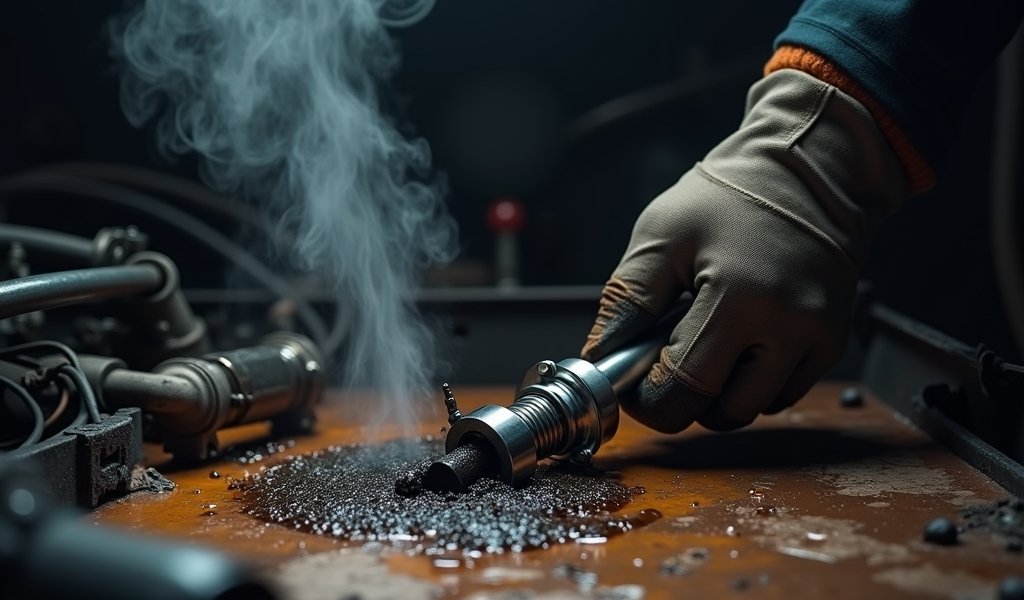Overview
The article explains how oil filter bypass valves work as a crucial safety mechanism that allows oil to flow to the engine even when filters are clogged, with detailed information on diagnosing problems, DIY repairs, professional options, and preventative maintenance. It emphasizes the importance of regular oil changes, using quality filters that meet manufacturer specifications, and paying attention to warning signs like unusual oil pressure readings to maintain proper bypass valve operation and protect engine longevity.
Table of Contents
- Understanding Oil Filter Bypass Valves
- How Oil Filter Bypass Valves Work
- Common Bypass Valve Problems
- Diagnosing Bypass Valve Issues
- DIY Solutions for Bypass Valve Repairs
- Professional Repair Options
- Preventative Maintenance Tips
- Choosing the Right Oil Filter
- Conclusion
- Frequently Asked Questions
Understanding Oil Filter Bypass Valves
The oil filter bypass valve is one of those unsung heroes in your engine that keeps things running smoothly even when conditions aren’t ideal. In my 20+ years as a mechanic, I’ve seen how this small component can make a huge difference in engine longevity. The bypass valve serves as a critical safety feature that ensures your engine receives adequate oil flow even when the filter becomes clogged or when oil is extremely cold and viscous.
Think of the oil filter bypass valve operation as your engine’s insurance policy. When everything’s working normally, oil passes through the filter, getting cleaned of all the nasty particles that could damage your engine. But what happens when that filter gets gunked up? That’s where our little friend, the bypass valve, steps in to save the day.
Most vehicles come with this valve built into either the oil filter itself or the filter housing on the engine block. The design may vary between manufacturers, but the purpose remains consistent: to protect your engine from oil starvation when the filter can’t do its job effectively.
Remember, dirty oil is better than no oil at all. The bypass valve ensures your engine components receive lubrication even if it means temporarily allowing unfiltered oil to circulate. This might sound counterintuitive, but trust me, your engine would much rather deal with some contaminants than run dry and suffer catastrophic damage.
How Oil Filter Bypass Valves Work
Let’s break down the oil filter bypass valve operation in simple terms. The valve is basically a spring-loaded device that remains closed during normal operation. When your engine is running as expected, oil pressure pushes oil through the filter media where contaminants are trapped, and clean oil flows to your engine parts.
The magic happens when something goes wrong. If the filter becomes clogged with debris or if the oil is too thick (like during a cold start in winter), pressure builds up against the bypass valve. Once this pressure exceeds the spring resistance—usually around 11-30 PSI depending on your vehicle—the valve opens.
When open, the valve creates an alternate pathway for oil to flow around the filter element directly to your engine. Think of it like a detour on a highway when the main road is blocked. It’s not the ideal route, but it keeps traffic (or in this case, oil) moving when necessary.
Most modern engines have sophisticated oil filter bypass valve operations that can respond to varying conditions. For instance, during cold starts when oil is thick and sluggish, the bypass might temporarily open until the oil warms up and flows more easily through the filter. This intelligent oil management system helps protect your engine during those critical first moments after startup.
The beauty of this system lies in its simplicity. With just a spring and a valve, your engine has a reliable failsafe mechanism that requires no electronics, sensors, or computer control. It’s old-school mechanical engineering at its finest—reliable, effective, and brilliantly simple.

Common Bypass Valve Problems
Despite their simple design, bypass valves aren’t immune to problems. In my years turning wrenches, I’ve encountered several common issues that can plague these crucial components. Understanding these can help you spot trouble before it leads to serious engine damage.
The most frequent culprit is a stuck bypass valve. Like any mechanical component, these valves can become stuck either open or closed—both scenarios spell trouble for your engine. A valve stuck open means oil constantly bypasses the filter, leaving your engine vulnerable to contaminants. Conversely, a valve stuck closed forces oil through a potentially clogged filter, restricting flow and potentially starving your engine of lubrication.
Spring fatigue is another issue I’ve encountered regularly. Over time, the spring that controls the valve can weaken, causing the bypass to open at lower pressures than designed. This results in oil bypassing the filter too easily, reducing filtration efficiency. You might not notice this problem immediately, but over time, it can accelerate engine wear.
Contamination buildup around the valve mechanism is particularly common in vehicles that have gone too long between oil changes. This gunk can prevent the valve from seating properly or moving freely. I’ve seen valves completely seized with carbon deposits and sludge—a clear sign of neglected maintenance.
Another overlooked problem involves damage during filter changes. Improper installation techniques or using the wrong filter can damage the bypass valve or affect its operation. This is why I always recommend following manufacturer specifications for oil and filter selection and proper installation procedures, as noted by Engine Builder Magazine in their comprehensive guide to oil filtration.
Diagnosing Bypass Valve Issues
Spotting bypass valve problems early can save you from expensive engine repairs down the road. Fortunately, your vehicle usually gives some telltale signs when the oil filter bypass valve operation isn’t up to par.
One of the most common indicators is unusual oil pressure readings. If you notice your oil pressure gauge showing lower than normal readings, especially at idle, it might indicate a bypass valve stuck in the open position. Conversely, abnormally high pressure could suggest a valve stuck closed, forcing oil through a clogged filter.
Pay attention to your engine’s performance too. A bypass valve malfunction can lead to reduced engine performance, as proper lubrication is essential for optimal operation. You might notice a slight power loss, rough idling, or even increased fuel consumption—all subtle hints that something’s amiss with your oil system.
Contamination in the oil is another red flag. If an oil analysis shows higher than normal levels of metal particles or debris, it could indicate that unfiltered oil is circulating through your engine due to a stuck-open bypass valve. Regular oil analysis can be an invaluable diagnostic tool for serious car enthusiasts or those with high-performance engines.
For the DIY-minded, there’s a simple test you can perform during an oil change. Carefully examine the old oil filter after removal. Excessive debris or metal particles inside the filter could indicate a bypass issue. Additionally, inspect the bypass valve itself (if accessible) for signs of damage, corrosion, or stuck operation.
Listen to your engine, too. Unusual ticking noises, particularly during cold starts, might indicate oil starvation to vital components—a possible symptom of bypass valve problems. These sounds shouldn’t be ignored, as they often precede more serious damage.
If you’re experiencing any of these symptoms, consider consulting with a professional mechanic who can perform more detailed diagnostics. Modern shops have specialized equipment that can accurately measure oil pressure and flow, helping pinpoint bypass valve issues with greater precision.
DIY Solutions for Bypass Valve Repairs
For those of you who love getting your hands dirty, there are several DIY approaches to addressing oil filter bypass valve operation issues. Before diving in, I should mention that the feasibility of these repairs depends on your vehicle’s design and your comfort level with automotive repairs.
The simplest fix often starts with changing your oil and filter. Fresh, clean oil and a quality filter can resolve minor bypass valve issues, especially if the problem stems from contamination or a partially clogged filter. When doing this, always use the manufacturer-recommended oil viscosity and a quality filter that meets OEM specifications.
If your vehicle has a separate bypass valve assembly that’s accessible, you might be able to clean or replace it. Start by locating the valve—typically found on the oil filter housing or the engine block near the filter mount. After ensuring the engine is cool and the pressure relieved, carefully remove the valve assembly.
Cleaning a bypass valve requires patience and attention to detail. Soak the valve in a quality parts cleaner to dissolve built-up gunk and sludge. Use compressed air (carefully!) to blow out passages, and a soft brush to remove stubborn deposits. Be gentle with the spring mechanism, as it’s calibrated precisely for your engine’s needs.
For those with cartridge-style oil filters, check if the bypass valve is integrated into the filter housing. In many modern vehicles, the entire housing can be disassembled for cleaning or the bypass valve may be replaceable separately. Fixing oil system components like these requires careful attention to gaskets and seals to prevent future leaks.
Here’s a simple step-by-step process for DIY bypass valve maintenance:
- Drain the engine oil completely
- Remove the oil filter or filter housing
- Locate and remove the bypass valve (if separate)
- Clean or replace the valve as needed
- Inspect all gaskets and O-rings, replacing if necessary
- Reassemble with care, ensuring proper torque on all fasteners
- Refill with fresh oil and a new filter
- Run the engine and check for leaks and proper oil pressure
Remember that some bypass valves are not serviceable separately and may require replacement of the entire oil filter housing or oil cooler assembly. In these cases, it might be more cost-effective to seek professional help, especially if you lack the specialized tools needed for the job.

Professional Repair Options
There are times when DIY just doesn’t cut it, and that’s okay. Professional repair for oil filter bypass valve operation issues offers several advantages, especially for complex systems or when you’re not entirely comfortable tackling the job yourself.
When you take your vehicle to a professional shop, they’ll start with a thorough diagnostic process. This typically includes a detailed oil pressure test using specialized equipment that can identify precise pressure variations at different engine speeds. These tests can pinpoint exactly what’s happening with your bypass valve under various operating conditions—something that’s difficult to achieve in a home garage.
Professional mechanics also have access to factory service information and specialized tools designed specifically for your vehicle model. This means they can often access and service bypass valves that might be buried deep in the engine or integrated into complex assemblies. According to Motor Magazine’s research, proper diagnostic equipment is essential for accurate oil system troubleshooting.
The repair options a professional might recommend include:
- Replacement of the entire oil filter housing assembly
- Installation of an upgraded bypass valve with improved design
- Cleaning and service of the oil galleries and passages
- Complete oil system flush to remove contaminants
- Replacement of related components like oil coolers or pressure sensors
While professional repairs typically cost more than DIY solutions, they often come with warranties and guarantees that provide peace of mind. For complex modern engines with integrated oil management systems, professional service might actually save money in the long run by preventing improper repairs that could lead to more serious damage.
When choosing a shop, look for technicians with specific experience in oil system repairs for your make and model. Specialty shops or dealerships often have more expertise with the peculiarities of your specific vehicle’s oil filter bypass valve operation than general repair facilities.
Preventative Maintenance Tips
An ounce of prevention is worth a pound of cure—especially when it comes to your engine’s oil system. Taking proactive steps to maintain proper oil filter bypass valve operation can save you from headaches and expensive repairs down the road.
Regular oil changes are your first line of defense. I can’t stress this enough: follow your manufacturer’s recommended oil change intervals or even opt for more frequent changes if you drive in severe conditions. Fresh oil helps prevent the buildup of contaminants that can affect bypass valve function.
Oil quality matters tremendously. Always use the grade and specification recommended for your vehicle. Modern engines are engineered with tight tolerances that require specific oil formulations. Using the wrong oil can lead to pressure issues that might cause the bypass valve to operate incorrectly.
Consider your driving habits and environment when establishing a maintenance schedule. Short trips, extreme temperatures, dusty conditions, and heavy loads all place additional stress on your oil system. In these cases, more frequent maintenance might be necessary to ensure proper bypass valve function.
Engine flushes can be beneficial for older vehicles or those with suspected sludge buildup. A professional flush can help clear deposits that might be affecting bypass valve operation. However, this should be done cautiously, as aggressive flushes can sometimes dislodge debris that ends up causing blockages elsewhere.
Keep detailed maintenance records to track oil pressure readings and any symptoms that might indicate developing bypass valve issues. This history can be invaluable for spotting trends before they become serious problems. Many modern vehicles have oil pressure sensors that can be scanned with diagnostic tools to check for proper operation.
Finally, consider periodic oil analysis—a laboratory examination of your used oil that can reveal valuable information about engine condition and oil system function. This relatively inexpensive test can identify excessive wear metals or contaminants that might suggest bypass valve problems before they cause noticeable symptoms.
Choosing the Right Oil Filter
Your choice of oil filter plays a critical role in bypass valve health and overall engine protection. Not all filters are created equal, and the right selection can make a significant difference in oil filter bypass valve operation.
When selecting a filter, always prioritize meeting or exceeding the manufacturer’s specifications. This means looking at factors like filter media quality, bypass valve pressure rating, anti-drainback valve function, and overall construction quality. Bargain-bin filters often compromise on these critical elements.
Consider the filter media’s efficiency and capacity. Higher-quality filters typically offer better particle capture capabilities while maintaining good flow characteristics. This balance is crucial—a filter that’s too restrictive may cause the bypass valve to open prematurely, while one that’s too permissive won’t adequately protect your engine.
For high-performance applications or severe driving conditions, consider premium filters with synthetic media. These filters often feature improved flow characteristics and dirt-holding capacity, which can help reduce stress on the bypass valve during extreme conditions.
Pay attention to the bypass valve specification in the filter itself. Some aftermarket filters use different spring rates than OEM specifications, which can alter when the bypass activates. This is particularly important in modern engines with specific oil pressure requirements.
For vehicles with remote filter mounts or cartridge-style filters, ensure you’re using the correct gaskets and O-rings when replacing filters. Improper sealing can lead to pressure loss that affects bypass valve function. As noted by Machinery Lubrication experts, proper filter selection is a critical aspect of effective oil system management.
Don’t forget to consider filter change intervals as well. Extended-life filters might seem convenient, but they place additional demands on the bypass valve as they approach the end of their service life. For optimal bypass valve health, changing filters at regular intervals is always preferable to pushing them to their limits.
Conclusion
Understanding oil filter bypass valve operation is more than just mechanical trivia—it’s essential knowledge for anyone who wants their vehicle to go the distance. This humble component plays a crucial role in protecting your engine under less-than-ideal conditions, ensuring that vital parts receive lubrication even when the filter becomes restricted.
Throughout this article, we’ve explored how bypass valves work, the common problems they face, and both DIY and professional approaches to addressing these issues. We’ve also covered preventative maintenance strategies and filter selection tips to help you maximize the life of your engine’s oil system.
Remember that proper oil filter bypass valve operation depends on a holistic approach to maintenance. Regular oil and filter changes, using quality products, paying attention to warning signs, and responding promptly to problems are all part of keeping this system in peak condition.
Whether you’re a dedicated DIYer or someone who prefers to leave it to the professionals, staying informed about your vehicle’s oil system helps you make better maintenance decisions. Your engine is a significant investment—protecting it with proper oil system care is one of the smartest moves you can make as a vehicle owner.
By following the guidance outlined here, you can help ensure that your oil filter bypass valve continues to perform its vital function, providing your engine with the protection it needs for years of reliable service.
Frequently Asked Questions
What happens if an oil filter bypass valve fails?
A failed bypass valve can either restrict oil flow (if stuck closed) or allow unfiltered oil to circulate (if stuck open). Either condition can accelerate engine wear and potentially lead to serious engine damage if left unaddressed.
How often should a bypass valve be serviced?
Most bypass valves don’t require specific service intervals, but they should be inspected during oil filter housing replacements or whenever oil pressure issues occur. Regular oil and filter changes help prevent bypass valve problems.
Can I drive with a faulty bypass valve?
It’s not recommended to drive with a known bypass valve issue. While you might not experience immediate engine failure, continued operation can lead to accelerated wear and potentially catastrophic damage.
How much does it cost to replace a bypass valve?
Costs vary widely depending on vehicle make and design. Simple bypass valves might cost $20-50 for parts, while integrated assemblies can run $200-500 plus labor for replacement.
Do all oil filters have bypass valves?
Most oil filters contain bypass valves, though some vehicles have the valve built into the engine block or oil filter housing instead. Almost all modern engines incorporate this safety feature somewhere in the oil filtration system.

